American Psycho: A Post Modern Horror

In the cult horror film American Psycho directed by Mary Harron, and originally a novel written by Bret Easton Ellis, we can see a post modern rendering of a classic ‘slasher’ horror film. Through elements in the film such as having it narrated and shown from the point of view of the main character, serial killer Patrick Bateman, we are given a psychological analysis of him that blurs the line between the human and the monstrous. Through its historical settings and anxieties as well as references to other works of art in music and film we see its critique of the 1980s young urban professional culture.
With this blurring of fiction and history we can see the consumerism that created such a character through an excess of wealth, greed and jealousy. Through its ambiguous ending we are given a story that blurs the lines between reality and fiction and with an inconclusive ending it shows the insanity of one who lives out his horrific repressed desires but still cannot distinguish fantasy from reality. Each of these aspects along with its many references to past serial killers, fictional and historical, elements of the yuppie culture and ambiguous twists shows this film to be a post modern portrayal of a serial killer and a monster that would look normal to any human eye.
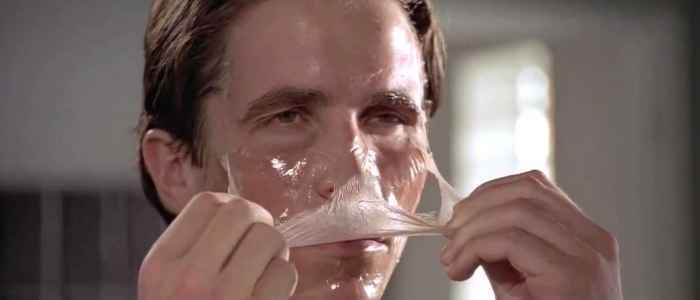
Patrick Bateman’s Disguise
The majority of post modern aspects in American Psycho can be seen through the main character Patrick Bateman played by Christian Bale. This character, though completely human, can be seen almost as a modern day vampire. There is nothing supernatural about him and though he is human the way he thinks makes him anything but as he states, “I have all the characteristics of a human being: flesh, blood, skin, hair, but not a single clear identifiable emotion except for greed and disgust.” Patrick works out and sculpts his body rigorously every morning as well as taking overly good care of his skin. This is “Because I want to fit in,” he says and this in some ways makes him more horrifying than most stereotypical serial killers. This is because his image is an illusion and an appealing one which can draw in his victims, as Jaap Kooijman and Tarja Laine write in their essay “Bateman embodies both the well-groomed image of the Wall Street yuppie and the gruesome image of a serial killer” (46).
As most post modern horror films such as the 1980s film Psycho suggest, there can be monsters among us even within our own homes or in Bateman’s case where we work, even ones with normal appearances. A scene which effectively links these two aspects together is when he is taking off his herb mint facial mask which looks as though he is removing his skin to reveal his true identity. During this scene he states,
“There is an idea of a Patrick Bateman, some kind of abstraction but there is no real me, only an entity, something illusory. And though I can hide my cold gaze and you can shake my hand and feel flesh gripping yours and maybe you can sense our lifestyles are probably comparable. I simply am not there.”
From this quote and the very fact that the film is seen from this character’s point of view, as well as being narrated from his own thoughts, the film gives a somewhat post modern psychological analysis of his character as he slowly undergoes his transition into a serial killer. This is expressed as he states, “Something horrible is happening inside of me and I don’t know why. My nightly blood lust has over flown into my days. I feel lethal on the verge of frenzy. I think my mask of sanity is about to slip.”
We also see this disguise as he goes from picking out suits for camouflages, skin creams in his bathroom, to picking out murder weapons, knives from his pantry. However we are not fully aware whether he has been killing this whole time or that it has just now started to slip up into his real life; his repression coming out into the open. This is shown in the film as he starts bringing in quotes from past serial killers into his everyday conversations. He references murderers such as Ted Bundy and Ed Gein who inspired characters for the Hannibal films, as well as admitting his actions to his co-workers which they take only as jokes or simply mishear what he is saying; an example being him saying “murders and executions” which is mistaken for “mergers and acquisitions.”
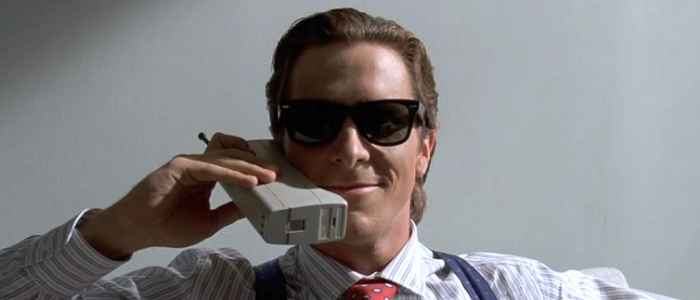
Yuppie Culture
The many references to other works of art in American Psycho are another element of post modernism. This is also connected with Patrick’s mask of sanity and his need to fit in. In order to seem normal or have anything ordinary to talk about with his co-workers, as well the escort girls he tries to entertain before killing, he listens to and reads about many different music albums and musicians. References are given to Witney Huston, Phil Collins and he even kills his co-worker Paul Allan with an axe to the song by Hewey Lewis and the News; Hip to be Square. These songs and artists, as well as always mentioning famous rich people, show how hollow his mask of sanity really is. This music also tells something of the materialistic times which the film is set in, as Brian Lavery states when mentioning the origin of Ellis’s character in an interview, “Robert Martin Ellis (Bred’s father) may have died a year after he served as the inspiration for Patrick Bateman, American Psycho’s yuppie serial killer” (1).
The blurring of history and fiction is a common sign of a post modern narrative and in American Psycho there are many references given to the times of the American yuppie culture. Yuppie stands for young urban professional and was a common lifestyle of the young, rich and powerful in and around the 1980s. The fact that Patrick is one of these, almost destined to be one by his upbringing and his “father practically owning the company” that he works for shows the entrapment of his true nature. This is stated as the author Bret Easton Ellis says, “The murders are fantasies, ways of escaping the culture he’s trapped in.” He even says himself that his only reason to keep his job is to fit in. It is also his freedom of having money and jealousy of his co-workers that leads him to most of his self corruption, many of his murders being prostitutes and the poor, which shows a simple critique of this time.
By the scene when he is chasing one of his escort girls, which he names Christie, she runs into a room where there is “die yuppie die” smeared in blood on the wall. Through this we can see the extent of his self loathing. It is this scene in particular that also makes an important reference in the film and at the same the time expresses a very important critique. Earlier in the film we see him doing stomach crunches while watching The Texas Chainsaw Massacre. In the scene with Christie running away from him he runs after her with a chainsaw as though inspired by this. This shows Patrick’s inability to distinguish fantasy from reality and it is this element which goes on to show how truly psychotic and insane he has become. The fact that the yuppie culture and this historical blurring takes place also shows the anxieties of this time. However unlike most horror films where the fears and anxieties come from a place unknown, with the main character being the serial killer himself the anxieties behind American Psycho come instead from the viewer’s own urges within, mainly the repression of their horrific fantasies.
We are Patrick Bateman
The anxieties behind American Psycho are of giving in to ones desires and fantasies no matter how horrific they may be. The ‘slasher’ genre of horror fiction as Adam Rockoff Jefferson states, “is not taken very seriously among film historians; film critics and many horror film fans hold it in disdain. Considered the bastard child of the horror film, no other type of film has the bad reputation that the slasher film does.” (450). However in this genre where the killer’s identity is usually unknown until the end, American Psycho gives a post modern approach to this where not only is he revealed from the very beginning to be the killer but that the film is seen from his point of view.

Because we are seeing it through his eyes, unlike the fear of being murdered the main fear the audience experiences is not the thrill of a threat for ones life but instead a thrill of the threat of getting caught. This gives the viewer the feeling that they themselves have committed these crimes. The following is same with the drug culture of the time as it shows Patrick and his co-worker sniffing cocaine in the men’s bathroom at a night club, a line behind them ready to do the same as though it is nothing out of the ordinary. Because of writing this even Bret Easton Ellis had been under suspicion as in an interview Richard Ousounian states, “Bret Easton Ellis began this interview with a visit to the men’s room. On his return, there were no telltale sniffles or traces of white powder, but it raised the issue of how he felt about the world keeping him under constant surveillance.”
The fact that Patrick Bateman pretends to be normal as a cover for his true motives brings out the fear that our own personal fantasies and secrets maybe discovered. Many times in the film Patrick’s face is blurred by a screen, a bad reflection or even by having it partly smeared with blood which expresses the idea that we can not truly understand his desires let alone our own. Patrick Bateman is not a normal human with moments of insanity; Patrick is insane with moments of normal humanness. This can be seen when he represses his urges and decides not to kill his secretary, Jean, but it is at this moment in the film where he starts committing more and more murders.
The fact that Patrick’s desires are so grotesque shows how monstrous he is; from playing with people’s body parts to eating parts of their brains as Martin Rogers states,
“Aside from its own “formal” expressions of the monster-function, one would expect a monstrous body (or perhaps a figure of embodied monstrosity) to appear in the text – some locus of horror to be identified, in Carroll’s words, “in terms of threat and disgust” The source of the novel’s repulsive overkill is ostensibly Patrick himself, though he is a handsome and financially successful yuppie. Describing Patrick as a monster is a solely moral-critical act based on his homicidal behavior” (231).
This can show the possibility of how far someone can fall because of repression as he states, “I need to engage in homicidal behavior on a massive scale. It cannot be corrected but I have no other ways to fulfill my needs.” The effects of Patrick’s repression finally comes to a climax when he cannot distinguish fantasy from reality; the main twist at the end of film revealing that he may not have even taken part in these murders at all.
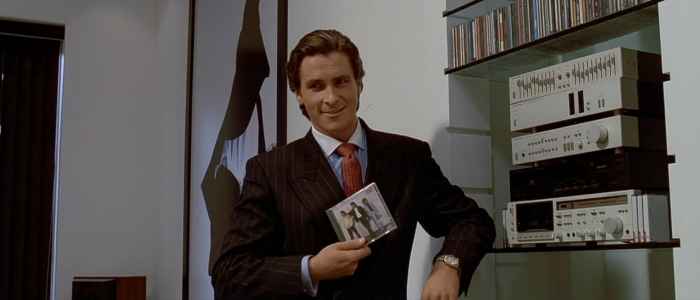
Product of the Times
In many respects this film shows a critique of materialism and consumerism as well as, to a further extent, sexism. Patrick is always trying to own expensive things and eat at expensive places, in particular the restaurant Dorsia which he can never get a reservation at. Even right after killing Paul Allan he is shocked to find out that his apartment is more expensive than his own as he states in his narration, “There is a moment of sheer panic when I realized that Paul’s apartment overlooks the park and is obviously more expensive than mine.” However it is this consumerism which connects with his fetishes, even at the beginning what we assume to be blood is actually some kind of sauce going on some exquisite dish. This links in at the end where instead of consuming foods, furniture or music CDs he instead resorts to be consuming people for the rush of killing them and going so far as to try and cook and eat one of his victims brains.
It could be seen that consumption is the only thing that excites him now that everything he may need in the lines of money is simply at the tips of his fingers, killing people giving him excitement money cannot buy. This consumerism is also shown in his need to buy escort girls to fulfill his sick desires as many of his murders, like many serial killers in the past, are prostitutes. Martin Rogers states,
“Many critics who note the influence of horror-video on American Psycho use slasher films to emphasize Patrick Bateman’s empty consumerism, misogyny, and narcissism to express Patrick’s exploitation of/violence against otherness or to indicate the consuming/hegemonic nature of finance capitalism/ corporate yuppiedom” (231).
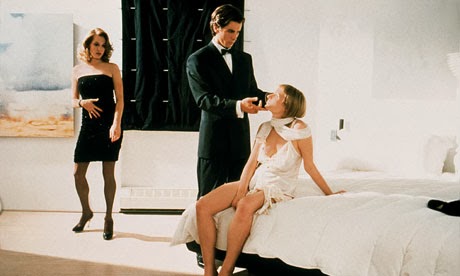
Feminist Response to the Film
This film also garnered criticism from feminist perspectives; many women believing the film and even the original book to be sexist because of its graphic violence towards women. Ironically one of the feminist activists for the books release was Gloria Steinem who is the stepmother of Christian Bale, the man who played Patrick Bateman in the film. However, there were also female supporters of the book as Alison Kelly states, “critics rave about it, academics revel in its transgressive and postmodern qualities, and for all the angry charges of misogyny, it has prominent female defenders, including Fay Weldon, who called it “beautiful, careful, important” and (no arguing with this one) “seminal”.”
An entire scene from the film is dedicated to Patrick and his friends talking down on women as they say in unison such things as “There are no girls with good personalities” before high-fiving each other. This shows the hypocrisy of Patrick’s mask as earlier on in the film Patrick delivers a speech on values and equal rights for woman. It is this change along with Patrick’s mutilated drawings of woman in his date book which shows the critique of the sexist culture in this time.
Post Modern Ambiguity
Not being able to distinguish fantasy or dream from reality is another aspect of a post modern film. Throughout the film the identities of the main characters are constantly being swapped around and mistaken for other people as critic Tony Rayns states in his review, “identikit personalities lead to recurrent cases of mistaken identity, intense emotional crises are triggered only by fears of losing status in the food chain.” An example is the fact that the first co-worker we see him kill, Paul Allan, mistakes him for another co-worker and constantly calls him by the name Marcus, even going so far as to insult Bateman right in front of him because of it.
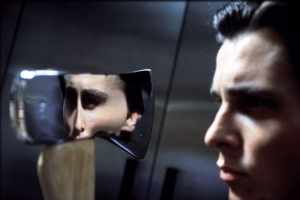
This swapping of identities can be seen primarily through the passing around of business cards in which they all take pride in; Patrick in particular is driven to kill a homeless man after he realizes that Paul Allan’s card is better than his own. In the climax of the film where he kills multiple people and a few policemen, he rings up and confesses all his crimes to his lawyer. The next day when he goes to the apartment where he had hidden all the bodies, they had all been cleared out, the apartment had been painted and it smelt strongly of flowers as though to hide the smell. When he asks about it he is told strangely to leave, leaving him questioning if the events had even happened.
This ambiguity in film grows when he tries talking to the lawyer he had left a message on the phone to who states that it was a joke, that he had talked to Paul Allan a few days ago and constantly calls him Davis, even stating in front of him that, “Your story had one fatal flaw, Bateman is such a dork.” Parallel to this scene it shows his secretary, Jean, finding his date book with the drawings of his many different murders and mutilations. This raises the question for both the audience and himself on whether he actually committed these murders or if they were all in his head. This shows the blurring of reality in this post modern film to the point that he says, “my punishment continues to elude me and I gain no deeper knowledge of myself. No new knowledge can be extracted from my telling. This confession had meant nothing.”
We are not told whether he committed these crimes and they were covered up or if they had all been in his head and his note book to begin with as Ellis himself states when talking in an interview, “Whether or not he actually killed all those girls is left open in the book.” Being left without the knowledge of if he did or did not commit these crimes, if they were reality or fantasy, leaves the ending intentionally open showing the post modern element through its ambiguity.
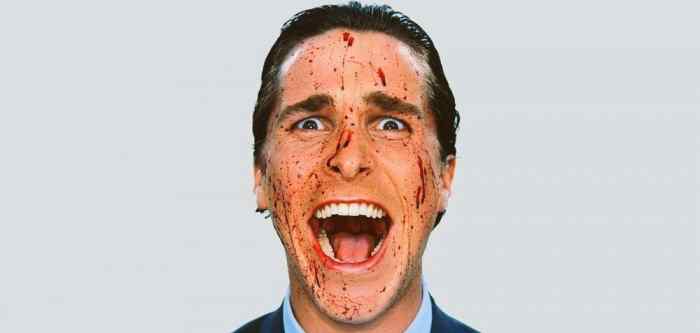
Despite its controversial nature and horrific content, American Psycho is a near perfect example of a post modern horror. Not only does it break common treads in horror archetypes and structure but its critique of consumerism and materialism gives the film a post modern complexity as an analysis of both an insane character and a time in American history. This complexity can be seen dominantly through the ambiguity of its ending which questions the line between fantasy and reality in the film.
Its references to works of art in and around the time of its setting as well as the style of the film itself shows a critique of the 1980s yuppie consumer culture while blurring the line between history and fiction. Its references to other serial killers, whether it be fictional in the Texas Chainsaw Massacre or in reality with the people who inspired them such as Ed Gein and Ted Bundy, shows a blend in the genre of fiction and real life.
Most importantly is the fact that this character gets away with it. Because of the inconclusive ending, not understanding whether he committed these murders or not due to his manipulated view of reality we are given a complex ending not for entertainment but to open up levels of thought on whether these fantasies make him guilty or not, and in turn, ourselves for our own fantasies.
Works Cited
Adam Rockoff Jefferson, Going to Pieces: Rise and Fall of the Slasher Film, Weiner, Robert G, Journal of Popular Culture, November 2004; 38, 2; Proquest, Pg450
Alison Kelly, Imperial Bedrooms by Bret Easten Ellis, The Observer, Sunday 27 June 2010
Brian Lavery, Psycho therapy;Literature, The Sunday Times, 6 November 2005-Jaap Kooijman and Tarja Laine, American Psycho: A double portrait of serial yuppie Patrick Bateman, University of Massachusetts Lowell, 20 Feb. 2008, Pg. 46
Martin Rogers, Video Nasties and the Monstrous Bodies of American Psycho, Literature/Film Quarterly 39.3, (2011); 231-244
Richard Ouzounian, My dad, Patrick Bateman; Author’s issues propel oddly personal new work, Toronto Star, 18 September 2005
Tony Rayns, Tony Rayns is the editor of Wong Kar-Wai, Copyright British Film Institute, May 2000-Bret Easton Ellis, American Psycho, Vintage Books, New York, 1991
Carol Clover, Men, Women and Chain Saws: Gender in the Modern Horror Film, Journal of Film and Video: Women in Film, Princeton, University of Illinois Press; 1992, Pg260
Frederic Jameson, Postmodernism and Consumer Society, The Anti-Aesthetic: Essays on Postmodern Culture (1989), (http://people.virginia.edu/~jrw3k/enwr/1067/readings/Jameson_Postmodernism_and_Consumer_Society.pdf)
Graham, Elaine L., Representations of the Post/Human Monster, Aliens and Others in popular Culture, Rutgers University, March 2002 ,Pg. 288
American Psycho directed by Mary Harron (Lion’s Gate Films 2000)
What do you think? Leave a comment.











This was a great analysis of a lot of things we’ve all encountered, but not pieced together so well. Thanks for the awesome article, and keep up the great work!
Thank you. I will try to keep my next article to the same standard but maybe not as long.
Great read!
Thank you.
American Psycho is one of my favorite movies of all time, and you article perfectly demonstrates why. I find the whole backlash the film got from critics at first was very strange to me. It could be they focused too much on the intense violent and sexist nature, that they forgot to review it as a film first. It could be that the film that was just ahead of its time, which is why it has gained a cult following.
That maybe the case. It’s funny how time turns the controversial into the artistic.
My mother told me I’d like this movie even though she thought it was mediocre, but I really enjoyed it.
I find people generally judge films on their ending and it’s end gives the impression of being very inconclusive.
I hope you relationship has improved in the last seven years.
Christian Bale isn’t just an actor, he’s a shape shifter.
Indeed, I don’t think there’s ever been a transformation as dedicated as his weight comparison between the Machinist and Batman Begins. That’s method acting for you though.
I was expecting a more slasher/gory approach but I was very satisfied with what I got nonetheless.
Perhaps that was one of the reasons for it’s controversy, it shattered expectations.
Intelligent analysis of this film. I had forgotten how good it was. I’ll need to rent it again soon.
It was pretty unique, I’ll give it that much.
That was very indepth.
Thank you, I spend more time on research than I did on either watching the film or writing it.
Quite insightful. I enjoyed reading it.
I appreciate that.
This is without a doubt, one of the best performances in Christian Bale’s career.
I’m glad you said ‘one of the’ before finishing that sentence because he has done some amazing stuff.
This movie is awful. It is badly written and as an awful ending. It is not scary. I keep hearing it is comedy. Where is the hummer? I have seen comedies were I can tell there are play something for laughs and I just did not think it was funny. But do not see this movie as bad comedy. I do no see it has being comedy at all. Serial killer is one a spear. This movie is not good for people who want to get scared. It for people who like to laugh ether. It is for people who like to see a lot of fake blood. I thought is was a badly made horror movie not a comedy. Good actors wasted there talent being in this awful movie.
Call me pessimistic and I might be wrong, but I have a feeling you didn’t read this post.
No one knows if all the things that Patrick Bateman does in American Psycho are actually happening or are all in his mind.
The ambiguity is one of the major reasons it’s considered post modern.
Great analysis!
When I first watched American Psycho, with my dad nonetheless, I enjoyed it, was confused by the ending, and was left more curious than I was before watching, while my dad simply hated it.
I think this article pinpoints why I was intrigued by it so. Thank you.
Glad I could help.
A great social commentary.
Ah… thank you?
I am in love with American Psycho, because even if most people won’t admit it, Patrick Bateman is essentially an extreme version of our weirdest, deepest thoughts and emotions.
If I was that rich, I might go insane as well.
Not as true to the book as one may expect, but if it was it would probably be banned.
What it adds and takes away works really well instead of just replicating the written work to visuals. One of my all time faves, one of my earliest faves and one of my faves that won’t be removed from my top 10 best movies of all time.
It’s one of the few films that I’ve lost count how many times I’ve watch it.
I love how you touched base on how ‘We are Patrick Bateman’ because that is a post-modernism theme to a T. American Psycho brings in the revolution that the killer is one of ‘us’; a member of society going about their lives. Psycho ushers in a new era of thinking like the killer, almost routing for him. What a wonderful paper!
Glad to know I was barking up the right tree.
I can see how it can be viewed as sexist. Interesting article.
These day it’s hard to find things that people don’t view as sexist.
The Naked Chainsaw chase scene!!
I know!!
The main theme of this movie adaption was hit in the first paragraph: Consumerism. With the ambiguity of his actual crimes in the end of the movie, I think there is a shine to what the real evil is in the world. With the emphasis of his ‘daily routine’, monetary compulsion, and obsessive nature of material things, the movie builds a monster in definition of his consumerist nature. While the end leaves the viewer in doubt of him being a serial killer, the constant is the sloth he has become for the material wants of consumerist america.
Spot on.
It is up put to the viewer to decide.
Truly great article! I loved the fact that the ending was very perplexed whether he was completely insane or if he actually murdered all those people and everyone utterly didn’t seem to care because of their social status. Thank you for your analysis.
Thank you for reading.
I love this movie as well. I think one of the key points of this movie is as you said “We are Patrick Bateman.” Typically the killer in the horror film is contained in his otherness. Something normal people fear and slink away from, but in this version of the horror story the killer is, in fact, immersed in and generally accepted in society. His otherness is blurred just as the line between reality and fantasy is blurred. I really enjoyed reading your insight on the film.
Yeah, it’s actually interesting how if the main character is the killer is finds out in twist at the end, where this is almost the reverse of that.
Really loved reading this awesome analysis!
Thank you.
Dark, funny, clever and mind-bending.
A review in six words.
Well written and thought provoking analysis of a modern classic. I have read the book and seen the film numerous times, your observations are spot on. The correlation between Patrick’s success and his disgust for those who are of similar status is the principal theme of the story and lends perspective to the other aspects of his character. Keep up the good work chap!
Will do, old boy, will do.
Overall a good analysis. One thing that might have been improved would have been if you had defined “post-modern” a little better. After reading the article I’m aware of how the film is different from prior slasher films, but not quite how that makes it “post modern”. Fun read though.
That’s because, depending on what academic discipline you follow, post modern doesn’t have a strict definition.
I loved the part where you mentioned the films critique of: Materialism, Consumerism and Sexism. This can reap further into a critique of Capitalism and Consumer culture as it is no coincidence that the film is set in New York.
Yup, a lot of that.
This was a wonderful read, I actually just watched the film last night and it seemed to be a heavy critique on consumerism. Your comparison of Bateman as a modern day vampire was very well spotted. My favorite part of your analysis is the section where you discuss the face blurring and the distortion of his reflection, and how that alludes to the distortion inside himself and perhaps in the eyes of the viewer. Excellent work!
Thank you, glad you enjoyed it.
This movie is one that no one ever anticipates from the start.
Yeah, it’s pretty out there.
patrick bateman is awesome
He is a very interesting character.
It is terrifying that people can hide who they r and have such dark thoughts without others even knowing. This article really brought my attentions to this fearful reality.
That’s great that my article had such an effect.
Really great read. I’m a huge fan of the film and I was always curious as to why there was so much in-depth talk of the various musicians and albums mentioned.
Yeah, most of the people that watch it end up with a lot of questions.
Although I am not a huge fan of the film, this article was an excellent analysis of the controversy and responses to the film. Great job.
Thank you, I appreciate that.
I haven’t watched the film, but I appreciate the fact that such an in-depth and well-written article can be written about a film. My perspective of “horror” films hasn’t been quite positive in the past, but this I may find to be of my liking because of the psychological nature of the picture. Thanks for sharing!
Great analysis of the Post Modern elements of the film. This film definitely broke grounds for both the slasher film and the horror genre.
It’s interesting to see that the film adaptation was actually far more darkly comedic than its source material. Bale’s portrayal of Bateman lends it that humorous vibe, especially the way in which his introspective narrations occur throughout the film. I had seen the film first and then read the novel, and it was pretty much a totally different experience, although similar in narrative.
You bring up an excellent point regarding the film being a post modern horror, which I think it does particularly well in establishing itself as given its tackling of issues surrounding yuppie culture and the greed, consumerism and narcissism associated with it.
It always confuses me when people assume that the representation of a violent or immoral act equates to condoning it. Bret Easton Ellis was called a misogynist for creating a misogynist character, but he created a misogynist character that is undeniably deplorable. The only people who come close to liking him are his equally deplorable friends. Similarly, many of Martin Scorsese’s movies deal with amoral subcultures (wall street, organized crime, etc.) and show them realistically, i.e. people doing terrible things and having a good time doing it until they finally face the consequences, at which point they are generally not sorry they did it, just sorry they got caught. He approaches violence and crime with an uncomfortably realistic lens, as does Mary Harron with American Psycho.
I liked a lot of your article. I love this film and agree with most of your ideas. However, a few critiques from a fellow writer: Be careful not to repeat yourself– some of your sentences are nearly identical. Shorten your quotes and integrate them into your own ideas rather than directly quoting several sentences. And though I agree with your thesis that the film is postmodern, your piece is missing the “so what?” component. Postmodernism is about being skeptical of culture and tradition, and there are a lot more big picture ideas you could connect this to: whether or not you think the skepticism is justified, the importance of free-thinking vs. conformity, or even how Harron uses cultural critique to legitimize the scorned slasher film genre (which you touch on, but could develop).
Hope you don’t mind my input. Thanks for a good read!
I hadn’t thought about how the “consumption” of committing in mass murders (and literally consuming the victims’ brains) parallels consumption in a capitalist society, a lifestyle that Ellis is satirizing here. Really interesting! The self-loathing of Bateman was something else that hadn’t really caught my attention until this article. I will have to consider these things the next time I watch the movie.
Great article. Love the comparison to being a modern day vampire. Never thought about it like that. Makes sense, though.
American Psycho is one of my favorite movies! This is a great and well written article; a great read. This article put a lot of things into perspective that I’m going to keep in my the next time I watch this movie.
Interesting article. I often think of “American Psycho” in a post-social media world. What would Patrick Bateman look like in today’s society of selfies, social media “statuses” and Instagram? I sometimes look at Millennials and see similar narcissistic characteristics. Could his character transfer into a newer generation? Or is Yuppie culture the only culture through which his character could be exemplified? Just some thoughts.
I never truly acknowledged the American Psycho as post modern, but you’re article nailed some definite qualities of the times. Its interesting to note that even his persona as murderer, that was built up throughout the film, is eventually is revealed to be just another facade towards the conclusion.
The film also explores a significant meta-narrative; how postmodernism constantly clashes with a pre-existing modern environment. International style architecture, white washed facades (eventually splattered within blood)… Perhaps the film is an example of not only post modernism… but its continual clash with older ideologies.
Great analysis. What is your experience reading the book versus watching the film?
I watched the film and enjoyed it. I appreciated the anti-consumerist message. A few years after seeing the film, I read the book and couldn’t get through it. I don’t think I made it past 50 pages. It was more horrific to read Patrick Bateman than it was to watch him on the screen, and I began to question the author’s intent and approach. I still haven’t been able to work out why it was okay to watch, but was terrifying to read (probably because of how strongly the book made me feel). You would think that visuals would have a stronger effect than text.
Loved this analysis, I have to wonder if you’ve read the book and what your thoughts are on it?
I appreciated your detailed insight with regard to the ambiguity of reality around Bateman’s actions in the film. The moment in which I believe this becomes most apparent is the point at which Bateman is using an ATM machine that orders him to feed it a cat. Up until then, his actions were far-fetched but at least plausible for the most part. But once the ATM comes up, asking for one of the tell-tale signs of a budding serial killer (animal abuse), reality takes a step back. From that point on in the film, everything is questionable.